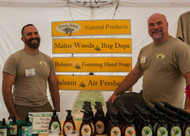Frenchies’ In The Media: When Indoor Air Goes Bad, It’s Time To Take Action (Featured in the Bangor Daily News)
Posted by Julia Bayly, Bangor Daily News on Mar 3rd 2018
“Indoor air pollution is the number one environmental threat, according to the [United States] Environmental Protection Agency,” said Kurt Johnson of the Maine Indoor Air Quality Council. “If you combine [volatile organic compounds] which can be brought inside with furniture, cleaning solutions or even the silicone in your television with any particles that can come from woodstoves, candles, pets or dust mites, you can have real problems.”
Volatile organic compounds — or VOCs — are any organic chemicals that have a high vapor pressure at ordinary room temperature and include both human-made and naturally occurring chemical compounds.
Common sources of VOCs include chemical cleaners, personal care products, paint strippers, solvents, moth balls, artificial air fresheners and aerosol sprays. Problems created by these VOCs, Johnson said, range from simply making things smell stuffy all the way up to causing human health issues like allergic reactions, headaches, nausea or serious respiratory issues.
Equal Air Exchange
The best defense against the indoor air pollutants, Johnson said, is a good offense.
“It’s really a two-pronged strategy,” he said. “Number one, don’t bring the pollutants in and, number two, for the ones that do get in, give them a way out.”
Some people tend to think that cleaning and sanitizing surface areas of the home with products like bleach or other chemical cleaners is a healthy option but that isn’t necessarily the case, Johnson said.
“People need to be more educated on what these are as threats,” he said. “They may think it’s a good idea to use these cleaners like bleach, but they don’t then think about breathing in the chemicals.”
Natural products like white vinegar or baking soda are just as effective for cleaning, Johnson said, and far safer.
“We need to realize, okay there are certain [pollutants] that are going get inside so we need a reliable way to get them outside,” he said. “In the summer we can simply open the windows but in the cold time of year, that becomes a comfort issue and a cost issue since you are trying to keep the heat inside, too.”
One strategy is installing air-to-air ventilation systems which pull in fresh outside while expelling stuffy inside air. These systems also transfer the heat from the outgoing air to the incoming air allowing for ventilation with minimal heat loss, Johnson said.
Backyard Solution
Cari Balbo, owner of Ridge Pond Herbals in Palermo, is a believer in keeping those pollutants out of the house in the first place.
“I am really very leery of, and feel it is unnecessary to use, chemicals in the house with cleaners or air-fresheners,” Balbo said. “There are too many links to health issues [and] to make something smell good by using chemicals to me does not make sense.”
Balbo understands that this time of year things can get a bit stuffy and stale.
“I heat with wood and I have pets,” she said. “But there are some simple things we can do to freshen things up.”
The simplest method Balbo said can be right out the back door.
“We are in Maine, so go outside and grab some conifer trimmings like spruce, or fir or pine and gently simmer a few bits on the stove or wood stove,” she said. “It will add that natural fragrance to the room and add a little humidity at the same time.”
Taking that idea one step further, Balbo said people can add in cloves, cinnamon or other pleasant smelling spices.
“We have so much available to us between our spice cabinets and what is out in the woods,” she said. “And they can really make our space smell nicer.”
Chemical Free
A popular, non-chemical option are essential oils made in Maine, which Balbo recommends using “judiciously.” An essential oil is a naturally occurring aromatic compound found in seeds, bark, stems, roots and flowers. The compound is distilled down to a powerfully fragrant liquid.
“They are wonderful, but you really need to be conscientious on how much you are using [because] they can be overwhelming,” Balbo said. “Just one or two drops can make a huge difference in making a room smell better.”
At Frenchies’ Natural Products in Yarmouth, Lou Demers and Matt Dubois create a number of chemical-free air and body products using ingredients from the Maine landscape.
“We specialize in making scents that smell like the north woods,” Demers said. “These products can freshen up a home without chemicals.”
For people like Dubois, natural scents are the way to go.
“I think there are a lot of people who are concerned with the amount of chemicals that are around as part of everyday life,” Dubois said. “When things are closed up in the winter it increases the risk of ingesting or breathing in chemicals, so why bring more inside? Why not use all natural products with no added chemicals?”
At the same time, Demers noted natural scents can help stave off the winter blues.
“This time of year we are often confined to the indoors and can get cabin fever,” he said. “One of the wonderful qualities of essential oils is they have transportive powers that can whisk you way to wherever.”

